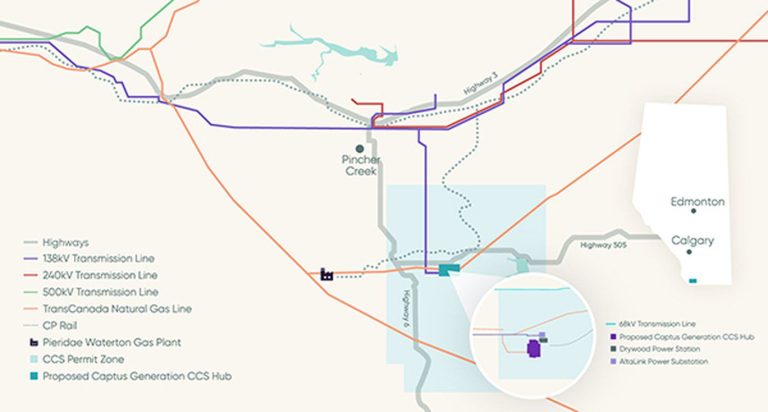Pincher Creek may see new energy plant
By Mia Parker, Local Journalism Initiative Reporter

Captus Generation is looking to build a natural gas-firing plant with incorporated carbon capture and sequestration in the MD of Pincher Creek.
The hub would be constructed on land purchased in Division 1 of the MD of Pincher Creek, situated directly above a depleted natural gas reservoir with wells travelling over three kilometres below the ground.
Captus Generation is a new company, established in December as a subsidiary of BTG Energy, a Calgary-based gas-firing energy company, with a plant established in Sylvan Lake. This new project would be a joint venture between BTG Energy and Westlake Petroleum.
Captus executive vice-president Mark Taylor says this project is really all about the location.
“There was a great location out here, because all the things you needed for a natural gas-fired power plant with carbon sequestration all lay in exactly the same spot,” he says.
The 850 acres of land purchased by Captus are near existing gas lines and the Pieridae Waterton Gas Plant, facilitating easy gas uptake. The already existing infrastructure would allow Captus to put energy onto the Alberta grid using nearby transmission lines.
The depleted gas reservoir below would allow for storage of captured carbon from generation emissions.
The proposed hub would consist of two general electric turbines, akin to jet engines on the ground, which would burn local gas. The carbon dioxide would then be captured, compressed and pushed back underground.
Between the 1950s and early 2000s, the site was operated as a Gulf Canada sour gas plant, with 18 wells drilled into a thick cap rock below. At the time, it was the largest single reservoir of wet natural gas found, according to a Government of Alberta tourism site.
The now-depleted reservoir held natural gas for millions of years prior to exploitation, making Captus confident that it can hold carbon effectively once again.
“We don’t need to build lots of pipelines to get the CO2 to where we want to put it in the ground,” says Taylor. “That saves money but it also reduces disturbance with the local community.”
According to the company, the plans to capture emissions would allow Captus to generate 24-7 carbon-neutral electricity.
“The technologies are there, what’s challenged everybody is the economics,” says Taylor, noting that companies trying to incorporate carbon capture without infrastructure from the onset to facilitate it face challenges trying to gather carbon from all over in an economically feasible way.
Once injected into the reservoir, below cap rock more than three kilometres underground, the company would be able to monitor pressure to ensure carbon stays down.
This depth keeps carbon dioxide kilometres below the water used for human consumption and agriculture, and far from the atmosphere.
Keeping carbon out of the atmosphere would help to slow the progression of the greenhouse effect of gases, including CO2, warming the planet’s overall temperature in recent years.
“If there was no government price on carbon, obviously there would be no economic benefit for capturing carbon dioxide,” says Taylor. But with the tax incentive and the proximity of infrastructure, Captus is confident that it can execute carbon capture without sacrificing revenue.
“It definitely stands out amongst the 26 projects that have been approved for evaluation in the province so far, because I’d say we’re one of maybe two that are actually economic at today’s prices,” he says.
Taylor spent five years as vice-president of operations at the Alberta Energy Regulator, and believes this project is relatively unique in the possibilities for clean energy generation from gas.
Currently, the project’s team is undergoing a consultation process, looking to make the final investment decision to go ahead with the project in early 2025, after which regulatory applications and equipment procurement would follow. The first energy is anticipated in 2029.
In a May 23 community information session, Taylor and Captus senior director Paul Connolly presented the project’s specific details to local stakeholders.
“Our vision is to bring carbon neutral power with carbon sequestration to Pincher Creek,” said Connolly. “There’s a lot of infrastructure that we hope to leverage into a successful project.”
The operating aim of the facility would be to capture 95 per cent of emissions, just under 900,000 tonnes of carbon a year.
The two generators would together generate around 200 megawatts of electricity, with roughly 170 for the grid and 30 used for carbon capture.
“We firmly believe that if this project doesn’t go ahead, there will be no other projects like it go ahead,” said Connolly. “This is such a robust opportunity.”
The Captus team also believes this opportunity would advantage the local community, largely in municipal tax revenue that has been seeing less of an oil and gas-based contribution in recent years, and in skilled jobs that would emerge from the site.
“We’re very cognizant of the fact that the opportunity that we see here will help drive a number of positive benefits to the community, and, frankly, for the province,” said Connolly.
